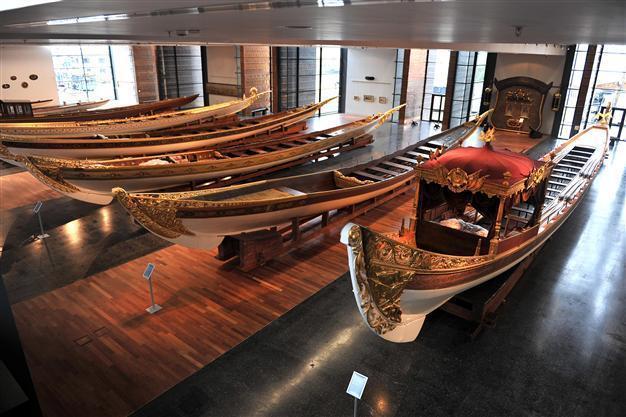Naval Museum reopening its doors soon
ISTANBUL - Anadolu Agency

The Naval Museum will be reopened on Oct 4 after a restoration process continuing since 2007. It displays a wide variety of items related to marine. AA photo
The Naval Museum in Istanbul’s Beşiktaş neighborhood, where renovation works have been ongoing since 2007, will reopen its doors on Oct. 4. The museum, the biggest of its kind in Turkey, is home to 20,000 artworks and archives of 20 million documents. The most treasured piece of the museum is the world’s oldest galliot.
The Naval Museum’s Commander, Fatih Erbaş, said the museum was founded in 1897 by Commander Süleyman Nutki and was moved from Istanbul from time to time for a variety of reasons. He said it served in Dolmabahçe Palace in 1948 after World War II and was then moved to its current location in Beşiktaş in 1961.
Erbaş said they had decided to widen the display area in 2005, organizing a competition to determine how the construction would go ahead, with the winning proposal being that which was implemented.
The main building of the Naval Museum has been constructed in line with that project.
“The construction of the main museum building started in 2007 and ended in 2011. The main building is home to a boats gallery as well as the Barbaros Hayrettin Paşa Exhibition Hall in the lower floor and the Süleyman Nutki Multi-Functional Hall in the upper floor. We also have a hall bearing the name of Haluk Şehsuvaroğlu, who served as the director of the museum for 15 years. The Çaka Bey Hall functions as a gallery for temporary exhibitions, on the lower floor. The museum also includes the administrational building and sales stores. The operation of the museum will be different after the end of restoration,” Erbaş said.
20,000 artworks in museum inventoryHe said the museum inventory included nearly 20,000 artworks. A historic galliot, which is the only one in the world, is the most notable piece in the museum. “It is presumed that the galliot belonged to the Ottoman sultan Mehmet II but research has showed that it dates back to the beginning of the 17th century, the term of Mehmet III. Galliots served as war tools on international waters for 2,000 years.
But this galliot was designed as a travel boat rather than a war tool,” he said.
Erbaş said history books referred to a galliot owned by the sultan Genç Osman. “We know that Murad VI is the younger brother of Genç Osman. He intended to keep the memories of his brother alive. It is believed that this galliot had been kept by him as a memoir of Genç Osman. The galliot is the world’s oldest one that was taken under protection before sinking,” he added.
He said the museum had 14 sultan’s boats, and most of them were from the 19th and 20th century.
Erbaş said the museum also included four copies of the Ottoman traveler Piri Reis’ “Kitab-ı Bahriye.”
Speaking about the importance of the museum’s archive, he said that it was the second biggest archive of the Ottoman period.
He said that works continued on archive to make it more digitalized. “Our archive is open to researchers. They can work with a very user-friendly system. We have some 20 million documents in the archive. They are from the 19th and 20th centuries. We also have maps, manuscripts and photographs as well as wood processing works, paintings, busts, firmans, garvaures, sultan signatures, etc,” Erbaş said.
Call for children and the youth“The museum is in the center of the city and it waits for you,” he said, calling out for children and families. He said they had contacts with provincial education directorates and invited schools to the museum for free.
Erbaş said the museum would be reopened on Oct. 4 and could be visited every day except Monday and Tuesday between 9 a.m. and 5 p.m. and between 10 a.m. and 6 p.m. at weekends. “The fee is 1.70 Turkish Liras for students and 5 liras for adults. Our goal is to increase the number of visitors to 200,000 a year,” he said.
